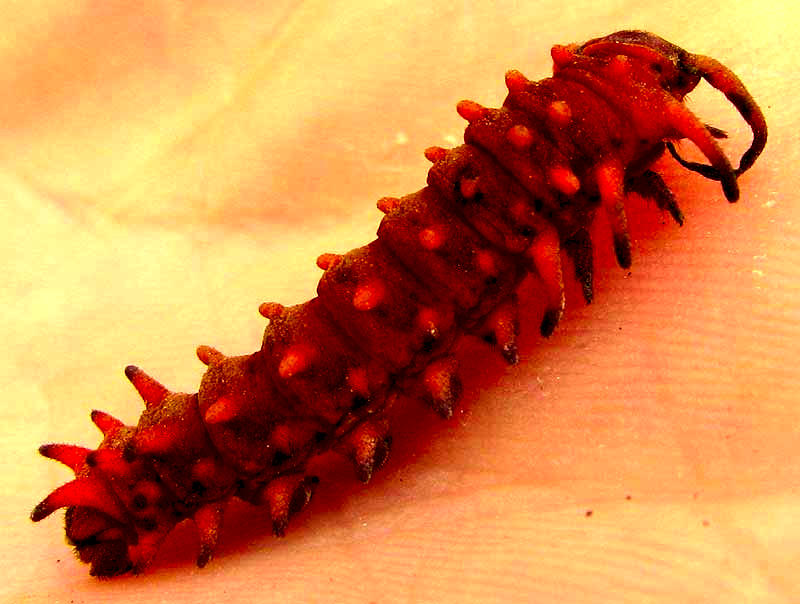Excerpts from Jim Conrad's
Naturalist Newsletter

from the June 2, 2013 Newsletter issued from the Frio Canyon Nature Education Center in northern Uvalde County, southwestern Texas, on the southern border of the Edwards Plateau; elevation ~1750m (~5750 ft); N29.62°, W99.86°; USA
PIPEVINE SWALLOWTAIL CATERPILLAR
On a hot, sunny day in mid afternoon, in the center of the gravel road running to the cabin, an orange caterpillar a little over an inch long (3cm) slowly made its way from one side of the road to the other. It was so hot I wondered how he'd traveled so far without succumbing to the heat. That's him above after he was retrieved from his little desert.
He's an unusual looking little fellow with those orange, finger-like spines and with such fleshy, downward-curved antennae on his head (the end at the top, right) being dragged along the ground. I figured there must be a story behind a brightly colored caterpillar allowing himself to be so clearly visible, even attention-getting, in such an inhospitable environment in the middle of the day, so off our picture went to volunteer identifier Bea in Ontario, who promptly replied that she'd been waiting for that very picture.
She'd been waiting because she knew that in our area maybe the most conspicuous butterfly awing at this season is the Pipevine Swallowtail, BATTUS PHILENOR, but until now I'd not sent her a picture of the Pipevine Swallowtail caterpillar. So, here it was. And that explained a bit.
For, Pipevine Swallowtail caterpillars eat the leaves of plants in the Pipevine Family, which contain chemicals that are poisonous to most animals, but not the caterpillars. Young caterpillars contain little of the poison but as they eat and grow the concentration of the poisons in their bodies increases until birds and other predators know better than to eat them. The caterpillars' bright orange coloration warns predators to stay away. Such poison-containing caterpillars that predators know to avoid don't need to restrict their travels to the night or to hidden passageways; they can cross a bright road in mid afternoon.
And, there's a reason why they might want to do it in the mid afternoon instead of waiting until the ground doesn't sizzle their feet. So far I haven't noticed any plant members of the Pipevine Family around here -- though there must be to support the large numbers of Pipevine Swallowtails -- so Pipevine Butterfly caterpillars must have to travel often looking for food.
Our orange caterpillar was a young one, for young Pipevine Butterfly caterpillars are known to be orange, but as they grow and approach the time when they metamorphose into a chrysalis they turn black, but retain orange-red spines, in which case maybe they look even more poisonous than when they were smaller and orange.